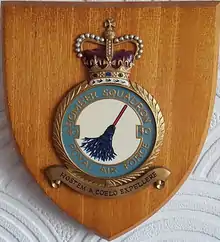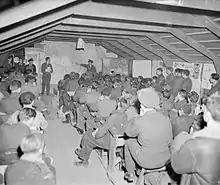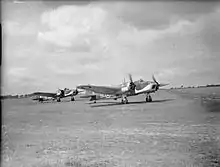No. 40 Squadron RAF
No. 40 Squadron of the Royal Air Force was formed in 1916 at Gosport as No. 40 Squadron Royal Flying Corps and was disbanded for the last time in 1957. The squadron also included many non-British members, including volunteers from the Royal Australian Air Force and Royal Canadian Air Force.
| No. 40 Squadron RAF | |
|---|---|
 | |
| Active | 26th February 1916 - 4 July 1919 1 April 1931 – 1 April 1947, 1 December 1947 – 15 March 1950, 28 December 1953 - 1 February 1957 |
| Country | |
| Branch | |
| Motto(s) | Latin: Hostem acolo expellere ("To drive the enemy from the sky")[1] |
| Insignia | |
| Squadron Badge heraldry | A broom. The broom was chosen to immortalise the frequent exhortation of Major 'Mick' Mannock, the famous World War I pilot, who served with the squadron, to "sweep the Huns from the air!" |
| Squadron Codes | OX Oct 1938 - Sep 1939 BL Sep 1939 - Apr 1947 LE Jun 1949 - Mar 1950 |
History
World War I
Edward Mannock gained 16 of his 61 victories while with 40 Squadron, 15 of which he shot down while flying a Nieuport Scout. Highest scoring ace of the unit in World War I was Irish-born pilot George McElroy, having scored 30 of his total 47 aerial victories with the unit while flying an S.E.5a single seater scout. Others among the two dozen aces who served were Roderic Dallas, Albert Earl Godfrey, Arthur Keen, Reed G. Landis, Ian Napier, William Leeming Harrison, Gwilym Hugh Lewis, Indra Lal Roy, John Henry Tudhope, Edwin Benbow, Herbert Ellis, William Bond, Gerard Crole, Robert Hall, John Wallwork.[2] Arthur Thomas Drinkwater & William MacLanachan.[3]
World War II

No. 40 operated Bristol Blenheim Mk IV light bombers from RAF Wyton from December 1939 until November 1940, when it converted to Vickers Wellingtons in the night bombing role. On the 14 April 1940 one of the Squadrons Blenheims (L9207) was taken on an unauthorized flight by AC2 JFB Lewis and crashed in the Thames Estuary. His body was not found and he is remembered on the Runnymede Memorial. After operating a detachment in Malta from October 1941, the squadron moved there in February 1942, the remaining UK-based element being renumbered No. 156 Squadron RAF.
It later moved to Egypt, Libya, Tunisia and then, in December 1943, to Italy. They participated in the successful Allied invasion of Sicily, concluding in August 1943. The Squadron re-equipped with Consolidated Liberators in March 1945.
Postwar
The Squadron returned to Egypt in October 1945, and converted to Avro Lancasters in January 1947, before disbanding in April 1947.
The squadron reformed in December 1947 at RAF Abingdon, flying Avro York transport aircraft. Taking part in the Berlin Airlift, it was later stationed at RAF Bassingbourn from June 1949 until disbanding in March 1950.
In December 1953, the squadron reverted to the bomber role, reforming with English Electric Canberra B.2s at RAF Coningsby, moving to RAF Wittering and then RAF Upwood before disbanding for what became the last time in February 1957. No. 40 Squadron was later twice slated for reformation, firstly as the first operational BAC TSR.2 squadron,[4] then with the General Dynamics F-111K.[5] However both aircraft were cancelled and the unit remained out of service.
Notes
- Pine, L.G. (1983). A dictionary of mottoes (1 ed.). London: Routledge & Kegan Paul. p. 101. ISBN 0-7100-9339-X.
- "40 Squadron". www.theaerodrome.com.
- Franks, et al, p. 63.
- McLelland, Tim (2010). TSR2: Britain's Lost Cold War Strike Aircraft. Ian Allan. p. 115. ISBN 978-1-906537-19-7.
- "What if the F 111K had entered RAF service as planned". www.whatifmodellers.com.
References
- Franks, Norman; Guest, Russell; Alegi, Gregory. Above the War Fronts: the British Two-seater Bomber Pilot and Observer Aces, the British Two-seater Fighter Observer Aces, and the Belgian, Italian, Austro-Hungarian and Russian Fighter Aces, 1914-1918: Volume 4 of Fighting Airmen of WWI Series: Volume 4 of Air Aces of WWI. Grub Street, 1997. ISBN 1-898697-56-6.
- No.40 Squadron info - the aerodrome
- Air of Authority - No 36 - 40 Squadron Histories
- RAF website
External links
| Wikimedia Commons has media related to No. 40 Squadron RAF. |
